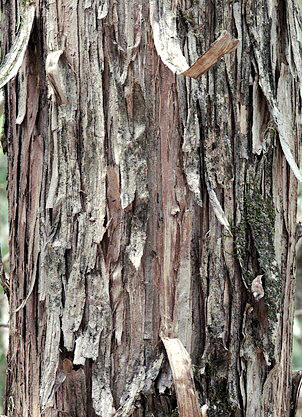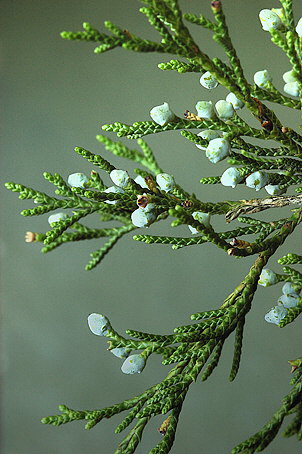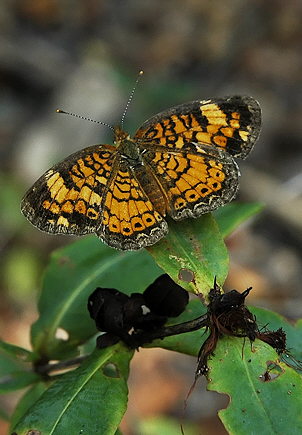| |
|
| |
 |
| |
Eastern Redcedar Leaves |
Habitat:
This is a pioneer species, and it tolerates virtually all soil
conditions except those that are quite swampy. Eastern Redcedars are
often among the first new species colonizing a habitat.
Identification:
This conifer is unmistakable in all seasons. The leaves
are bluish green to yellow-brown, paired on a four-angled stem.
| |
|
 |
|
|
Eastern Redcedar Bark |
The bark of the Eastern Redcedar is
gray to reddish-brown, thin and scaly - compare it's bark to that of
the Eastern Hophornbeam. The bark of older Eastern
Hophornbeams can look very similar to that of the Eastern Redcedar.
| |
|
| |
 |
| |
Eastern Redcedar Cones |
The berry-like fleshy
cones appear
in late summer and the fall, and are a light powder blue.
Other Uses
and Lore:
For many people,
the smell of a cedar tree conjures up memories of Christmas
mornings. The uses of cedar wood are many and varied. The ease
with which it could be worked and the wonderful textures in the wood
made it a favorite material for fashioning furniture in colonial
times. The wood’s resistance to pests continues to make it a
favorite for cedar chests.
The reddish color of the wood prompted the French of
Canada to call this tree the “baton rouge”, or “red stick.” When
they found the same tree in Louisiana, they gave the name to the
state capitol, Baton Rouge.
Pencil makers formally used Eastern Redcedar in vast
quantities to make pencils. According to Peattie, In Tennessee
alone, 3,000,000 feet of fine quality cedar was sent down the
Cumberland River in 1900 in great timber rafts to satisfy the need
for making pencils. The Faber Company was said to use only Eastern
Redcedar for its pencils.
The value of Eastern Redcedar to wildlife is
immense. Cedar waxwings regularly eat the cones and take their name
from this tree. Many other songbirds eat the light blue fleshy
cones, and the seeds of the eastern redcedar are often distributed
along fencerows in bird droppings. Many birds nest in Redcedars,
and owls such as the Eastern Screech-Owl often roost in the dense
foliage. The Eastern Redcedar is the host plant for the beautiful
olive hairstreak, a butterfly. Deer browse the leaves, and
small mammals make use of the cover it provides.
The
Trail From Station Seven to Station Eight
 |
| Pearl
Crescent |
From Station
Seven you will go down a small hill, and Station Eight will be on
the left side of the trail. There are many species of
butterflies that can be found along the trail. Shown at right
is a Pearl Crescent perched on a St. Johnswort plant. Look
carefully at the vegetation as you continue down the trail.
|

